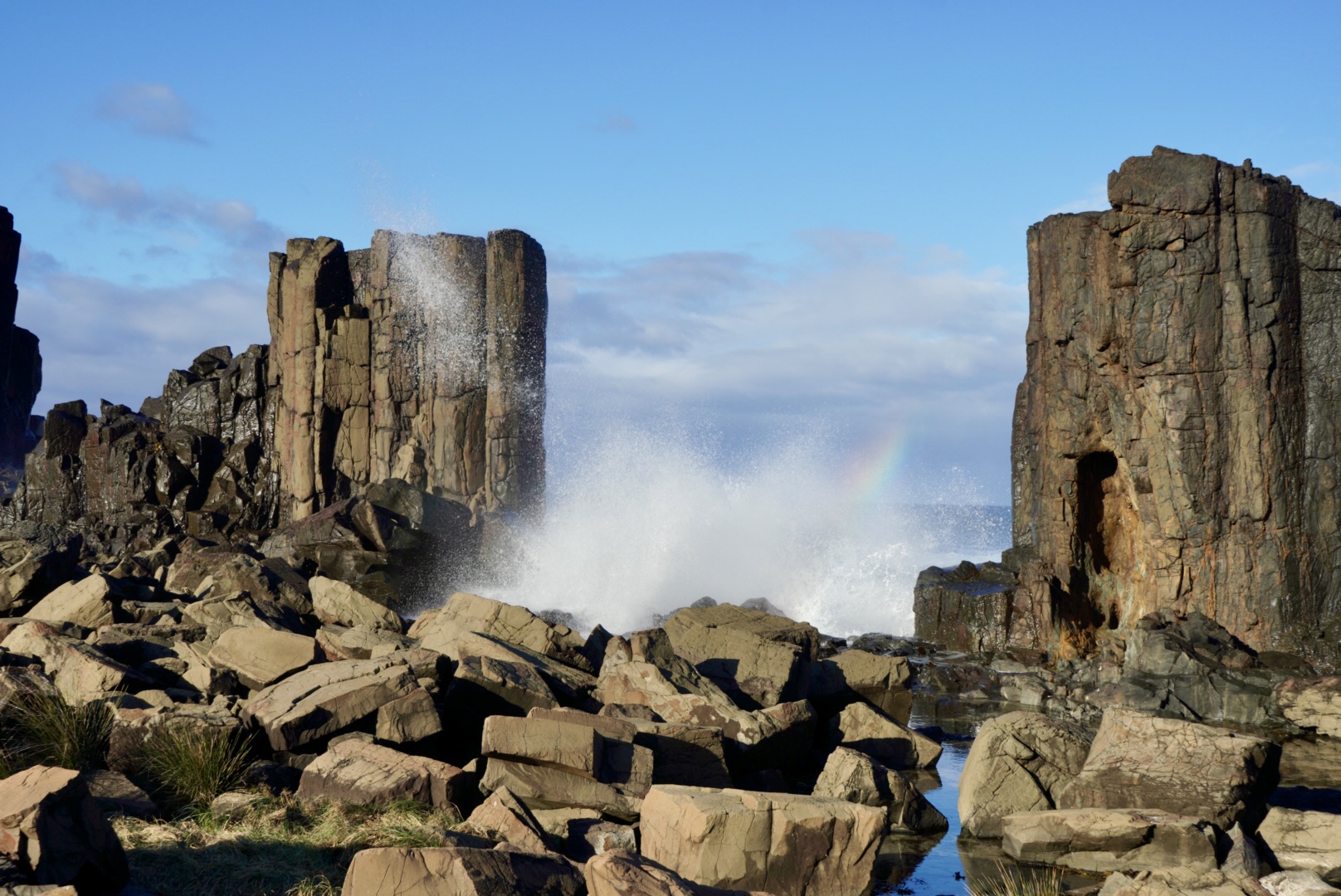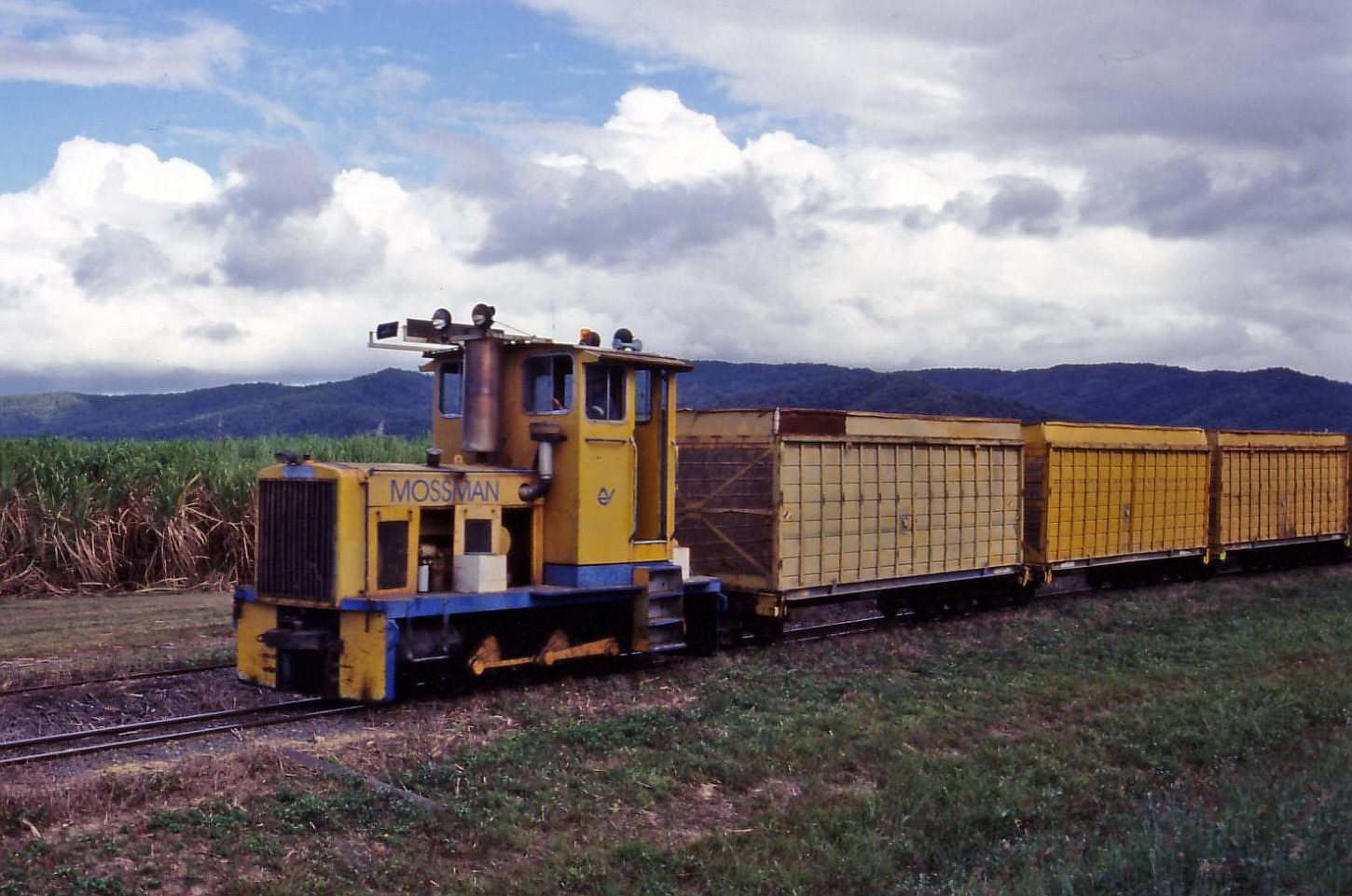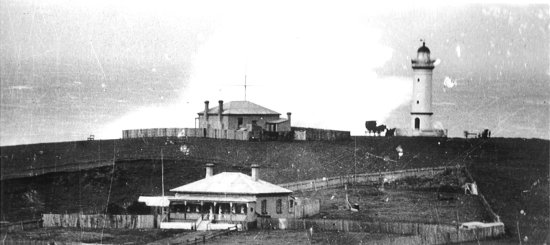|
Stone Fleet (New South Wales)
The Stone Fleet was the colloquial name for the small coastal ships that carried crushed-stone construction aggregate ('blue metal') to Sydney from the Illawarra ports of Kiama and Shellharbour and the nearby ocean jetties at Bombo and Bass Point. The coastal shipping trade carried on by these ships was known colloquially as the 'Stone Trade' or 'Blue Diamond Trade'. The trade ended finally in 2011. The 'Stone Trade' or 'Blue Diamond Trade' The predominant bedrock in the Sydney metropolitan area is sedimentary rock—Hawkesbury Sandstone with some isolated areas of shale. Crushed stone was needed as aggregate for concrete, road making, and as ballast for railways and tramways. Sandstone and shale are totally unsuited to such purposes, which typically use crushed igneous rock. There are some intrusions of igneous rocks in the Sydney area, particularly at Prospect Hill and Hornsby, but these isolated outcrops, although later quarried, were insufficient to meet demand. In the so ... [...More Info...] [...Related Items...] OR: [Wikipedia] [Google] [Baidu] |
Construction Aggregate
Construction aggregate, or simply aggregate, is a broad category of coarse- to medium-grained particulate material used in construction, including sand, gravel, crushed stone, slag, recycled concrete and geosynthetic aggregates. Aggregates are the most mined materials in the world. Aggregates are a component of composite materials such as concrete and asphalt; the aggregate serves as reinforcement to add strength to the overall composite material. Due to the relatively high hydraulic conductivity value as compared to most soils, aggregates are widely used in drainage applications such as foundation and French drains, septic drain fields, retaining wall drains, and roadside edge drains. Aggregates are also used as base material under foundations, roads, and railroads. In other words, aggregates are used as a stable foundation or road/rail base with predictable, uniform properties (e.g. to help prevent differential settling under the road or building), or as a low-cost exten ... [...More Info...] [...Related Items...] OR: [Wikipedia] [Google] [Baidu] |
Volcanic Vent
A volcano is a rupture in the crust of a planetary-mass object, such as Earth, that allows hot lava, volcanic ash, and gases to escape from a magma chamber below the surface. On Earth, volcanoes are most often found where tectonic plates are diverging or converging, and most are found underwater. For example, a mid-ocean ridge, such as the Mid-Atlantic Ridge, has volcanoes caused by divergent tectonic plates whereas the Pacific Ring of Fire has volcanoes caused by convergent tectonic plates. Volcanoes can also form where there is stretching and thinning of the crust's plates, such as in the East African Rift and the Wells Gray-Clearwater volcanic field and Rio Grande rift in North America. Volcanism away from plate boundaries has been postulated to arise from upwelling diapirs from the core–mantle boundary, deep in the Earth. This results in hotspot volcanism, of which the Hawaiian hotspot is an example. Volcanoes are usually not created where two tectonic plates slide pa ... [...More Info...] [...Related Items...] OR: [Wikipedia] [Google] [Baidu] |
Shellharbour Breakwater 1898 Glass Slide Collection (RAHS Photograph Collection) (27727367452)
Shellharbour (also known as Shellharbour Village) is a suburb located in the Illawarra region of New South Wales, Australia. It also gives its name to the local government area, City of Shellharbour, and its central business district, Shellharbour City Centre. The suburb is centred on the small recreational harbour named Shell Harbour. It has two main beaches: Shellharbour Beach, which runs to Barrack Point and Shellharbour South Beach, which runs toward Bass Point. Shellharbour hosts Harbourside Markets on the fourth Sunday of the month, in Little Park. History and culture The area was inhabited by indigenous Australians for thousands of years. European habitation began from about 1817 onwards. Shellharbour was originally known as ''Yerrowah'' and later as ''Peterborough''. Shellharbour's coastline is littered with 9 shipwrecks, and other historical sites like Bass Point which is home to various Aboriginal archaeological evidence. The shipwrecks date back to 1851, and a ... [...More Info...] [...Related Items...] OR: [Wikipedia] [Google] [Baidu] |
New South Wales Government Railways
The New South Wales Government Railways (NSWGR) was the agency of the Government of New South Wales that administered rail transport in New South Wales, Australia, between 1855 and 1932. Management The agency was managed by a range of different commission structures between 1857 and 1932, which reported to either the Minister for Public Works or the Minister for Transport. The inaugural Chief Commissioner was Ben Martindale and, following the enactment of the he became Commissioner of Railways. John Rae succeeded Martindale in 1861, and in 1877 Charles Goodchap was appointed Commissioner. The set up a corporate body of three railway commissioners to manage the railways and remove them from political influence, resulting in the resignation of Goodchap. This Board of Railway Commissioners of New South Wales was in place from 22 October 1888 to 4 April 1907, and was replaced by a sole Chief Commissioner of Railways and Tramways until 22 March 1932, when a panel arrangement ... [...More Info...] [...Related Items...] OR: [Wikipedia] [Google] [Baidu] |
Bombo Headland Quarry Geological Site
Bombo Headland Quarry Geological Site is a heritage-listed former quarry and now geological site at Princes Highway, Bombo, Municipality of Kiama, New South Wales, Australia. It is also known as Bombo Quarry. It was added to the New South Wales State Heritage Register on 2 April 1999. History In 1979 a nomination was received from the Geological Society of Australia (NSW Division) for the Bombo Quarry. The importance of the geological features was brought to the Heritage Council's attention by Dr. Suzanne Wass of Macquarie University's School of Earth Sciences. The quarry was owned by the Metropolitan Water, Sewerage, and Drainage Board and it was proposed that a pollution control plant be constructed on the floor of the disused quarry. It also made an appearance in '' Mighty Morphin Power Rangers: The Movie'' as part of the planet Phaedos. Following site inspections and lengthy consultations between the Metropolitan Water, Sewerage and Drainage Board, NSW Heritage Council ... [...More Info...] [...Related Items...] OR: [Wikipedia] [Google] [Baidu] |
Bombo Jetty
Bombo may refer to: Music * ''Bombo'' (musical), a 1921 Broadway production starring Al Jolson * "Bombo" (song), by Norwegian singer Adelén *Bombo criollo or just bombo, a family of Latin American drums *Bombo legüero, an Argentine drum *An 18th-century term for tremolo *An album from Swedish rock band Bonafide Places * Bombo, New South Wales, a suburb of the Municipality of Kiama, Australia *Bombo, Uganda, a town in Luwero District *A ward in Same District, Tanzania People * Aama Bombo, shaman in the Nepalese Tamang tradition *Bombo Calandula (born 1983), Angolan former team handball player * Bombo Rivera (born 1952), Puerto Rican former Major League Baseball player nicknamed "Bombo" Other uses *Bombo Radyo Philippines, a large Filipino radio network *, an Australian coastal freighter that foundered in 1949 * ''Bombo'' (video game), a 1986 British game on the Commodore 64 *Bombo, the ball used in chaza, a Colombian racquet sport See also * Bomba (other) * Bombe (d ... [...More Info...] [...Related Items...] OR: [Wikipedia] [Google] [Baidu] |
2 Ft Gauge Railways In Australia
A list of narrow-gauge railways in Australia. Installations See also * 2 ft and 600 mm gauge railways *Heritage railway * Narrow-gauge railways in Australia *Railways on the West Coast of Tasmania The history of the Railways on the West Coast of Tasmania has fascinated enthusiasts from around the world, because of the combination of the harsh terrain in which the railways were created, and the unique nature of most of the lines. Points of ... References External linksQueensland sugar cane railways today {{Navbox track gauge Narrow gauge railways in Australia ... [...More Info...] [...Related Items...] OR: [Wikipedia] [Google] [Baidu] |
Kiama Light
Kiama Light, also known as Kiama Harbour Light, is an active lighthouse in Kiama, New South Wales, Australia. The lighthouse is located close to the Kiama Blowhole on Blowhole Point, south of Kiama Harbour. History Tenders for the construction of the tower were called in 1886, ten years after Robertson Basin, a man-made basic, was opened in Kiama Harbour. The tower was commissioned on 1 January 1887. It was designed by Edward Orpen Moriarty MA MInstCE. The light was established in 1887. The original apparatus was an oil burner with a catadioptric fixed lens and light intensity of 600 cd. The characteristic was fixed green and it was visible for . Two houses were constructed, a principal lighthouse keeper's house close to the tower, and a one-story assistant keeper's house a bit further. In 1908 the power source was upgraded to coal gas with an intensity of 1,500 cd and a range of . A report from 1913 says that the light is unwatched and the keeper's house is empt ... [...More Info...] [...Related Items...] OR: [Wikipedia] [Google] [Baidu] |
Kiama Blowhole
The Kiama Blowhole is a blowhole in the town of Kiama, New South Wales, Australia. The name ‘Kiama’ has long been translated as “where the sea makes a noise”. It is one of the town's major tourist attractions. Under certain sea conditions, the blowhole can spray 50 litres of water up to 25 metres (82 ft) in the air, in quantities that thoroughly drench any bystanders. There is a second, less famous blowhole in Kiama, commonly referred to as the "Little Blowhole" by locals. It is much smaller than the other (called the "Big Blowhole"), but due to its narrow shape, it is more reliable than the Big Blowhole, and in the right conditions can be equally spectacular. The blowhole attracts 900,000 tourists a year. Kiama Blowhole is just a few metres beyond the coastline. The "little blowhole" is located at the Little Blowhole Reserve, Tingira Crescent, Kiama, 2 km south of the main blowhole. 2018 History The blowhole was formed from basalt lava flows approximately 260 ... [...More Info...] [...Related Items...] OR: [Wikipedia] [Google] [Baidu] |
The Harbour, Kiama (4903838158)
''The'' () is a grammatical article in English, denoting persons or things already mentioned, under discussion, implied or otherwise presumed familiar to listeners, readers, or speakers. It is the definite article in English. ''The'' is the most frequently used word in the English language; studies and analyses of texts have found it to account for seven percent of all printed English-language words. It is derived from gendered articles in Old English which combined in Middle English and now has a single form used with pronouns of any gender. The word can be used with both singular and plural nouns, and with a noun that starts with any letter. This is different from many other languages, which have different forms of the definite article for different genders or numbers. Pronunciation In most dialects, "the" is pronounced as (with the voiced dental fricative followed by a schwa) when followed by a consonant sound, and as (homophone of pronoun ''thee'') when followed by a ... [...More Info...] [...Related Items...] OR: [Wikipedia] [Google] [Baidu] |
Kiama Railway Station
Kiama is a heritage-listed intercity train station located in Kiama, New South Wales, Australia, on the South Coast railway line. The station serves NSW TrainLink diesel multiple unit trains traveling south to and electric multiple unit trains north to and Sydney. Early morning and late night services to and from stations to the south are provided by train replacement bus services. It was added to the New South Wales State Heritage Register on 2 April 1999. History As a seaside town, Kiama was initially reliant on coastal shipping for its links to Wollongong and Sydney. The railway first arrived in the Kiama district in November 1887, with the opening of a new station at (since renamed Bombo), on the town's northern outskirts. The terminus was only a temporary arrangement, however: the NSW Government Railways had already signed contracts to further extend the railway south the previous year. Kiama was the northernmost station on that extension, built by firm of W. Monie ... [...More Info...] [...Related Items...] OR: [Wikipedia] [Google] [Baidu] |
Bombo Railway Station
Bombo is a heritage-listed single-platform intercity train station located in Bombo, Municipality of Kiama, New South Wales, Australia, on the South Coast railway line. The station serves NSW TrainLink trains traveling south to Kiama and north to Wollongong and Sydney. It was added to the New South Wales State Heritage Register on 2 April 1999. History Bombo Station opened as the temporary South Coast Line terminus in late 1887 under the name "North Kiama". The town of Kiama, situated among fingers of hard basaltic rock running down from Saddleback Mountain to the sea, presented something of a barrier to the railway's progress further south. It had an open platform with a standard timber platform building completed in 1888, and due to its terminus status, received a turntable, watering facilities and an engine shed. This function was to continue until 1897, even when the line had been completed to Bomaderry in 1893. The site opened as North Kiama in 1887, changed to Kiama in ... [...More Info...] [...Related Items...] OR: [Wikipedia] [Google] [Baidu] |
.jpg)






.png)
